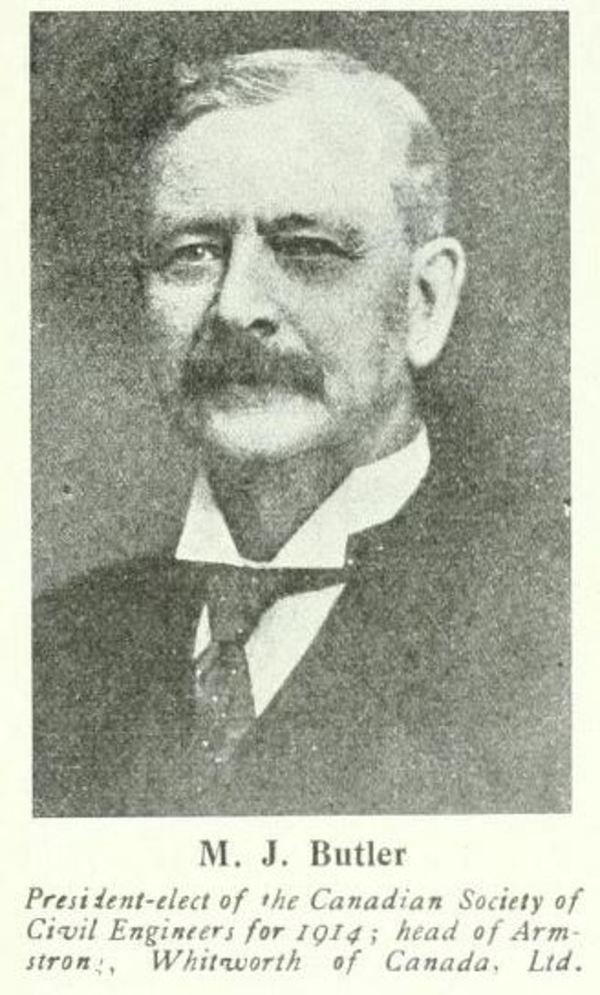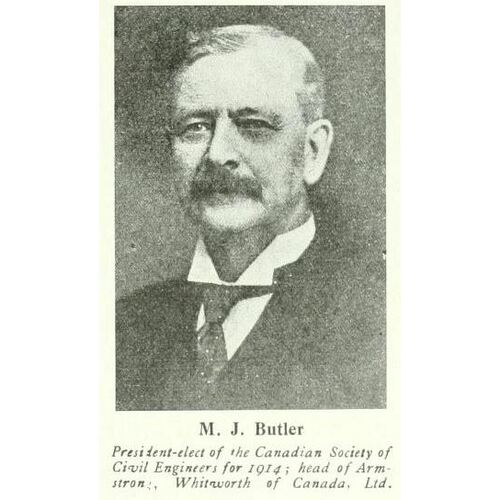
Source: Link
BUTLER, MATTHEW JOSEPH, civil engineer, businessman, civil servant, and author; b. 16 or 19 Nov. 1856 in Mill Point (Deseronto), Upper Canada, son of Tobias Butler and Elizabeth McVeigh (McVey); m. 13 Nov. 1880 Loretta (Loretto) Melissa Jane Shibley (1857–1932) in Napanee, Ont., and they had one son, who died in childhood, and three daughters, of whom one died in childhood; d. 22 June 1933 in Sydney, N.S.
After studying engineering at the University of Toronto, M. J. Butler served a three-year apprenticeship with the Belleville surveyors and architects John Dunlop Evans and Thomas Oliver Bolger. He qualified as a provincial land surveyor in 1878 and surveyed in southern and northwestern Ontario. He would remain active in the profession into the 1890s, but by the early 1880s his focus had shifted to railways. Butler became assistant engineer on the Kingston and Pembroke Railway (KPR) in 1882, and the next year he followed his father into the company H. B. Rathbun and Sons, a lumber concern based in Deseronto and managed by Edward Wilkes Rathbun*. Butler was appointed chief engineer of the firm’s recently acquired Napanee, Tamworth and Quebec Railway Company (NTQR). Under his direction, its main line was completed between Napanee and Tamworth and connected to the KPR at Harrowsmith, north of Kingston. His duties with the company also included industrial-design projects, such as improvements to the Napanee Cement Works. Following a two-year sojourn in Colorado in the mid or late 1880s as assistant engineer for building and water services for the Atchison, Topeka and Santa Fe Railroad, he worked in eastern Quebec as chief engineer and superintendent of a Témiscouata pulp and paper mill. In about 1891 Butler returned to Rathbun’s employ as chief engineer for the NTQR Company, now known as the Bay of Quinte Railway and Navigation Company. He remained with Rathbun until 1900, when a contractor for the Prince Edward Island Railway engaged him to create plans for a bridge over the Hillsborough River. In 1903–4 he designed and built workshops for the Locomotive and Machine Company of Montreal.
Like his colleague Robert Alexander Ross, Butler had large ideas about the role of engineers in modern society. He believed that their expertise and business acumen could help to modernize public administration, and the governments of Ontario and Canada took advantage of his multiplicity of interests. The royal commission on forestry protection in Ontario, chaired by Rathbun, solicited Butler’s expert advice on forests and rainfall, and the commission’s report, as well as the resulting Forest Reserves Act of 1898, embodied his recommendation that large forested tracts be set aside by the crown for future use. In 1900 the Liberal government of George William Ross* appointed Butler to the Ontario assessment commission, which was charged with investigating municipal taxation. Its reports recommended that the general property tax be replaced with a hybrid system that would tax income and the rental value of real property.
In 1905 the federal Liberal government of Sir Wilfrid Laurier* appointed Butler as Collingwood Schreiber*’s replacement in the position of deputy minister and chief engineer of the Department of Railways and Canals. He served first under Henry Robert Emmerson* and then, from 1907, under George Perry Graham*. In his first two annual reports Butler pushed for the creation of a pension scheme for the employees of publicly owned railways, and the Laurier government responded by establishing a plan for workers on the Intercolonial and Prince Edward Island lines. Two years later Graham and Butler attempted to depoliticize the Intercolonial by replacing its general manager with a board of management chaired by the deputy minister. The board closed the railway’s Halifax workshops and introduced principles of scientific management into its newly centralized maintenance operations in Moncton. Although the Conservative government of Robert Laird Borden, which took office in 1911, would restore the general-manager model to the Intercolonial, Butler’s reforms presaged the application of business principles to future public enterprises such as the Canadian National Railways, which would be managed by Sir Henry Worth Thornton. In 1909–10 Butler, citing the Hudson Bay Railway’s barren subarctic route, high costs, and brief operating season, persuaded the Laurier government to postpone further construction of its partially completed main line. His public service as deputy minister earned him an appointment by King Edward VII as a companion of the Order of St Michael and St George.
Butler returned to the private sector in 1910, becoming general manager of two Nova Scotia companies, the Dominion Iron and Steel Company and the Dominion Coal Company, which had been effectively united the year before under the presidency of James Henry Plummer. Butler assumed responsibility for the coalmines at Springhill, the scene of a catastrophic 1891 explosion that killed mine manager Henry Swift* and 124 other men. Butler inherited a bitter strike begun there in July 1909 by members of the United Mine Workers of America (UMWA). The union was organized in the province by James Bryson McLachlan, who was based in Sydney. Butler adopted a paternalistic attitude: he yielded to some extent on wages and agreed to rehire many of the strikers, but refused to negotiate with their union, citing company policy. A friend and colleague from his Ottawa days, Minister of Labour William Lyon Mackenzie King*, predicted that the union’s resistance against so tenacious a manager would be futile. Indeed, under Butler’s leadership, the company broke the Springhill strike in May 1911, aided by the police, the militia, and hundreds of strike-breakers. Butler did not remain long with the company; he relocated to Montreal, where he helped to organize a Canadian division of Armstrong Whitworth, the British machinery and armaments manufacturer, and became its managing director. In 1914 he was elected president of the Canadian Society of Civil Engineers.
Butler retired in 1919 and settled in Oakville, Ont. He became interested in the history of Canadian engineering and penned biographies of prominent early engineers for the journal of the Engineering Institute of Canada, the successor (in 1918) to the Canadian Society of Civil Engineers. He contributed to the discussion of national energy self-sufficiency that animated both politicians and manufacturers during the early 1920s. In a 1923 article Butler proposed a freight rate for shipping Alberta coal that was well below that set by the Board of Railway Commissioners but greater than the cost of importing coal from the eastern United States. He also served on the institute’s committee on the fuel question, which sided with the railways in rejecting any below-market rate for shipping coal. In 1932, following the death of his wife, he moved to Sydney to live with his elder daughter. He died there of influenza on 22 June 1933. In his heyday, speaking at a conference of his peers in 1908, M. J. Butler had reflected that during his career he had seen engineering in Canada develop from a glorified trade into a respected profession. Engineers like him who combined their broad technical interests with an entrepreneurial spirit and a commitment to technocratic public service, were instrumental in this evolution.
Matthew Joseph Butler’s “Report of the deputy minister” for each year from 1905 to 1909 can be found in Can., Parl., Sessional papers, 1906–10 (annual reports of the Dept. of Railways and Canals, 1904/5–1908/9). His other writings include “The manufacture of natural cement …,” Canadian Soc. of Civil Engineers, Trans. (Montreal), 4 (1890): 97–101; “Forests and rainfall,” in Ont., Royal commission on forestry protection in Ont., Report, 1899 (Toronto, 1900), 21–29; “The shops of the Locomotive and Machine Company of Montreal,” Canadian Soc. of Civil Engineers, Trans., 18 (1904), pt.i: 57–63; and “A method of calculating a fair rate for the transportation of western coal …,” Engineering Journal (Montreal), 6 (1923): 531–34. He was a contributor to the Ont. assessment commission’s Report (Toronto, 1902; an interim report was published in 1901) as well as the co-author, with J. S. Dennis, of “Walter Shanly – a biography,” Engineering Journal, 9 (1926): 514–16.
LAC, MG 28, I277 (Engineering Instit. of Can. fonds, membership files), 20 (Matthew J. Butler, statement of professional record). NSA, “Nova Scotia hist. vital statistics,” Matthew Joseph Butler, death registration, 1933: www.novascotiagenealogy.com (consulted 26 July 2017). London Gazette, 25 June 1909. W. M. Baker, “The personal touch: Mackenzie King, Harriett Reid, and the Springhill strike, 1909–1911,” Labour (St John’s), 13 (1984): 159–76. Canadian Soc. of Civil Engineers, Report of annual meeting (Montreal), 1910 and 1914. “Convention of Canadian civil engineers …,” Construction (Toronto), 1 (October 1907–October 1908), no.4: 58–59. Ken Cruikshank, “The people’s railway: the Intercolonial Railway and the Canadian public enterprise experience,” Acadiensis, 16 (1986–87), no.1: 78–100. Engineering Journal, 2 (1919): 694; 6 (1923): 65; 7 (1924): 58, 79, 646. J. N. McDougall, Fuels and the national policy (Toronto, 1982). J. R. Millard, The master spirit of the age: Canadian engineers and the politics of professionalism, 1887–1922 (Toronto, 1988). H. V. Nelles, The politics of development: forests, mines & hydro-electric power in Ontario, 1849–1941 (Toronto, 1974).
Cite This Article
Forrest D. Pass, “BUTLER, MATTHEW JOSEPH,” in Dictionary of Canadian Biography, vol. 16, University of Toronto/Université Laval, 2003–, accessed December 28, 2025, https://www.biographi.ca/en/bio/butler_matthew_joseph_16E.html.
The citation above shows the format for footnotes and endnotes according to the Chicago manual of style (16th edition). Information to be used in other citation formats:
| Permalink: | https://www.biographi.ca/en/bio/butler_matthew_joseph_16E.html |
| Author of Article: | Forrest D. Pass |
| Title of Article: | BUTLER, MATTHEW JOSEPH |
| Publication Name: | Dictionary of Canadian Biography, vol. 16 |
| Publisher: | University of Toronto/Université Laval |
| Year of publication: | 2021 |
| Year of revision: | 2021 |
| Access Date: | December 28, 2025 |



